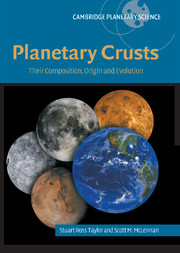Book contents
- Frontmatter
- Contents
- Preface
- Acknowledgments
- List of abbreviations
- Prologue
- 1 The planets: their formation and differentiation
- 2 A primary crust: the highland crust of the Moon
- 3 A secondary crust: the lunar maria
- 4 Mercury
- 5 Mars: early differentiation and planetary composition
- 6 Mars: crustal composition and evolution
- 7 Venus: a twin planet to Earth?
- 8 The oceanic crust of the Earth
- 9 The Hadean crust of the Earth
- 10 The Archean crust of the Earth
- 11 The Post-Archean continental crust
- 12 Composition and evolution of the continental crust
- 13 Crusts on minor bodies
- 14 Reflections: the elusive patterns of planetary crusts
- Indexes
- References
Prologue
Published online by Cambridge University Press: 22 October 2009
- Frontmatter
- Contents
- Preface
- Acknowledgments
- List of abbreviations
- Prologue
- 1 The planets: their formation and differentiation
- 2 A primary crust: the highland crust of the Moon
- 3 A secondary crust: the lunar maria
- 4 Mercury
- 5 Mars: early differentiation and planetary composition
- 6 Mars: crustal composition and evolution
- 7 Venus: a twin planet to Earth?
- 8 The oceanic crust of the Earth
- 9 The Hadean crust of the Earth
- 10 The Archean crust of the Earth
- 11 The Post-Archean continental crust
- 12 Composition and evolution of the continental crust
- 13 Crusts on minor bodies
- 14 Reflections: the elusive patterns of planetary crusts
- Indexes
- References
Summary
We are apt to judge the great operations of Nature on too confined a plan.
(Sir William Hamilton)It seems inevitable that rocky planets, like bakers, cannot resist making crusts, heat being the prime cause in both cases. Although trivial in volume relative to their parent planets, crusts often contain a major fraction of the planetary budget of elements such as the heat-producing elements potassium, uranium and thorium as well as many other rare elements while the familiar continental crust of the Earth on which most of us live is of unique importance to Homo sapiens. It was on this platform that the later stages of evolution occurred and so has enabled this enquiry to proceed.
Planetary crusts in the Solar System indeed have undeniable advantages for scientists: they are accessible. Unlike the other regions of planets that we wish to study, such as cores and mantles, you can walk on crusts, land spacecraft on them, collect samples from them, measure their surface compositions remotely, study photographs, or use radar to penetrate obscuring atmospheres. Despite this accessibility, the problems both of sampling or observing crusts are non-trivial: most of our confusion in deciphering the history of crusts ultimately turns on our ability to sample them in an adequate fashion. We discuss these diverse problems in the appropriate chapters.
This advantage of relatively easy access to crusts is also offset by the distressing tendency for crusts to be complex, so that one may easily become lost in the detail, failing to see the forest for the trees.
- Type
- Chapter
- Information
- Planetary CrustsTheir Composition, Origin and Evolution, pp. 1 - 4Publisher: Cambridge University PressPrint publication year: 2008

